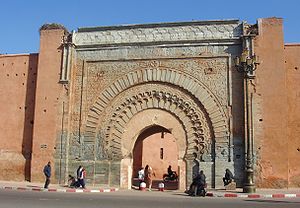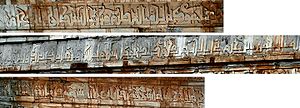
Bab Agnaou
Encyclopedia


Marrakech
Marrakech or Marrakesh , known as the "Ochre city", is the most important former imperial city in Morocco's history...
, Morocco
Morocco
Morocco , officially the Kingdom of Morocco , is a country located in North Africa. It has a population of more than 32 million and an area of 710,850 km², and also primarily administers the disputed region of the Western Sahara...
. It was built in the 12th century in the time of the Almohad
Almohad
The Almohad Dynasty , was a Moroccan Berber-Muslim dynasty founded in the 12th century that established a Berber state in Tinmel in the Atlas Mountains in roughly 1120.The movement was started by Ibn Tumart in the Masmuda tribe, followed by Abd al-Mu'min al-Gumi between 1130 and his...
dynasty.
The name Agnaou, like Gnaoua, in Berber
Berber languages
The Berber languages are a family of languages indigenous to North Africa, spoken from Siwa Oasis in Egypt to Morocco , and south to the countries of the Sahara Desert...
refers to black people (cf. Akal-n-iguinawen - land of the black). The gate was called Bab al Kohl (also referring to black people) or Bab al Qsar (palace gate) in some historical sources.
The function of the gate must have been representation, first of all. The corner-pieces are decorated with floral decorations extending around a shell. This ornamentation is framed by three panels and on these panels is an inscription from the Quran in Maghribi
Maghrebi script
Maghrebi script is a cursive form of the Arabic alphabet influenced by Kufic letters that developed in the Maghreb and later in Spain, particularly Andalusia.The Maghribi script can be divided in five other sub/scripts:...
, foliated Kufic
Kufic
Kufic is the oldest calligraphic form of the various Arabic scripts and consists of a modified form of the old Nabataean script. Its name is derived from the city of Kufa, Iraq, although it was known in Mesopotamia at least 100 years before the foundation of Kufa. At the time of the emergence of...
letters, which were also used in Al-Andalus
Al-Andalus
Al-Andalus was the Arabic name given to a nation and territorial region also commonly referred to as Moorish Iberia. The name describes parts of the Iberian Peninsula and Septimania governed by Muslims , at various times in the period between 711 and 1492, although the territorial boundaries...
. Bab Agnaou was renovated and its opening reduced in size, during sultan Mohammed ben Abdallah. Forerunners of this horseshoe-shaped gate with its corner-pieces, framed by inscriptions from the Quran can be found in the Mezquita
Mezquita
The Cathedral and former Great Mosque of Córdoba, in ecclesiastical terms the Catedral de Nuestra Señora de la Asunción , and known by the inhabitants of Córdoba as the Mezquita-Catedral , is today a World Heritage Site and the cathedral of the Diocese of Córdoba...
in Cordoba
Córdoba, Spain
-History:The first trace of human presence in the area are remains of a Neanderthal Man, dating to c. 32,000 BC. In the 8th century BC, during the ancient Tartessos period, a pre-urban settlement existed. The population gradually learned copper and silver metallurgy...
. It shows many similarities to the contemporary (much simpler) Bab Er-Rouah in Rabat
Rabat
Rabat , is the capital and third largest city of the Kingdom of Morocco with a population of approximately 650,000...
.
Bab Agnaou gives entrance to the royal kasbah
Kasbah
A kasbah or qassabah is a type of medina, Islamic city, or fortress .It was a place for the local leader to live and a defense when a city was under attack. A kasbah has high walls, usually without windows. Sometimes, they were built on hilltops so that they could be more easily defended...
in the southern part of the medina of Marrakech
Marrakech
Marrakech or Marrakesh , known as the "Ochre city", is the most important former imperial city in Morocco's history...
. The kasbah
Kasbah
A kasbah or qassabah is a type of medina, Islamic city, or fortress .It was a place for the local leader to live and a defense when a city was under attack. A kasbah has high walls, usually without windows. Sometimes, they were built on hilltops so that they could be more easily defended...
, built by the Almohad
Almohad
The Almohad Dynasty , was a Moroccan Berber-Muslim dynasty founded in the 12th century that established a Berber state in Tinmel in the Atlas Mountains in roughly 1120.The movement was started by Ibn Tumart in the Masmuda tribe, followed by Abd al-Mu'min al-Gumi between 1130 and his...
sultan Yaqub al-Mansour
Yaqub, Almohad Caliph
Abu Yusuf Ya'qub al-Mansur , also known as Moulay Yacoub, was the third Almohad AmirSucceeding his father, Abu Ya'qub Yusuf, Yaqub al-Mansur reigned from 1184 to 1199 with distinction. During his tenure, trade, architecture, philosophy and the sciences flourished, to say nothing of military...
, is the site of El Mansouria (the kasbah mosque), the El Badi Palace
El Badi Palace
El Badi Palace is located in Marrakech, Morocco, and these days it consists of the remnants of a palace commissioned by the Saadian Sultan Ahmad al-Mansur in 1578...
and the Saadian Tombs
Saadian Tombs
The Saadian tombs in Marrakech date back from the time of the sultan Ahmad al-Mansur . The tombs were only recently discovered and were restored by the Beaux-arts service...
.
External links
- Image of Bab Agnaou (click to enlarge): http://travel.webshots.com/photo/1382247923032656418XqZeDd
- With clear details (by Phil Douglis): http://www.pbase.com/image/72900080
- Close-up (by Phil Douglis): http://www.pbase.com/pnd1/image/72906446
- Bab Er-Rouah in Rabat (by Richard Ishida): http://www.flickr.com/photos/ishida/tags/baberrouah/
- Photograph of Bab Agnaou Cirac 1920's

